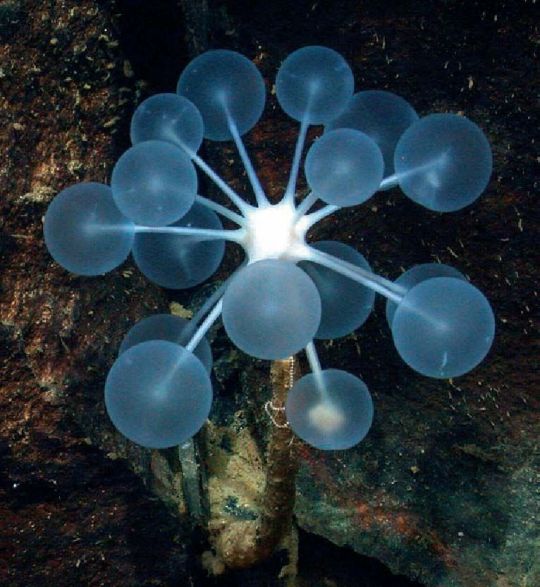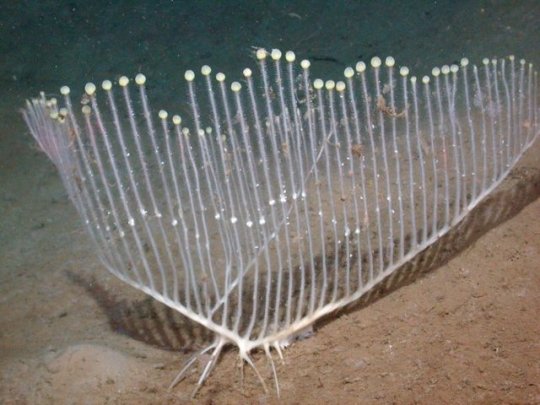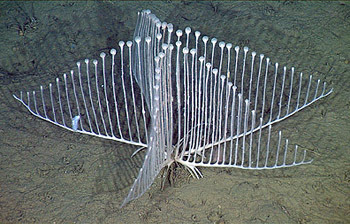#Chondrocladia lyra
Text
La découverte d'une étrange éponge Lyre [vidéo]
Nouvel article publié sur https://www.2tout2rien.fr/eponge-lyre/
La découverte d'une étrange éponge Lyre [vidéo]

#Californie#carnivore#Chondrocladia lyra#éponge#harpe#lyre#MBARI#Monterey#plongee#profondeur#sous-marin#USA#vidéo#animaux
0 notes
Text

The harp sponge (Chondrocladia lyra) is not like the other girls.
Most sponges are suspension feeders, meaning they filter bacteria and microorganisms out of the water with their aquiferous system.
This marvelous animal however, is a predator.
The branches of the sponge are lined with small barbs that snare passing crustaceans, which are then covered with a digestive membrane.
This unusual feeding strategy is likely due to the harp sponges' habitat, soft abyssal sediment off the coast of northern California, USA. Due to the low productivity in these areas it is more energy efficient to act as a set net rather than a filter.
#marine zoology#marine animals#marine life#marine biology#sponge#porifera#ocean animals#oceanlife#ocean
175 notes
·
View notes
Text
جولة في الحياة البرية أغرب أنواع الحيوانات
جولة في الحياة البرية أغرب أنواع الحيوانات
تقرير – ياسمين إبراهيم
حيوان إسفنجة القيثاره
هذا المخلوق الغريب لم يسبق وأن شاهده أحد قبل عام 2000، وذلك عندما تولى فريق من معهد خليج مونتيري لبحوث الأحياء المائية في ولاية كاليفورنيا غواصة في عمق 2 ميل قبالة الساحل يتم تشغيلها عن بعد،
والتقطوا عينتين من هذا الحيوان الذي يسمى علمياً Chondrocladia lyra،
وأطلق عليه اسم إسفنج القيثارة لأن بنيتها تشبه القيثارة، ومن ثم التقطوا أكثر من 10 فيديوهات…

View On WordPress
0 notes
Note
Elaborate on the ping pong balls

ohohoho you people are enabling me to talk about sponges aka my favorite beasts ever so THANK YOU. MUAH


this is the aptly named ping pong tree sponge (or chondrocladia lampadiglobus)!!! it's found in the deep sea and while most sponges are filter feeders, these ones catch and eat small crustaceans using modified spicules, which are essentially what makes up the (very disordered and weird, not at all connected, not actually a skeleton) skeleton in other sponges. the systems + cells that most sponges use to pull in and filter water are used to inflate these ballons in this group!! whats super cool is that the entire genus chondrocladia has over 30 species in it and all of them are carnivorous deep water sponges, some of them from the antarctic deep water, which is completely insane.
heres another one in the same genus, the harp sponge (chondrocladia lyra)!! all of the long thin spires in this one are COVERED in barbed hooks to catch crustaceans. wild!!

also weve only known that sponges COULD be predators for something like 30 years, and yet theres entire families that have specialized to be just that in some of the harshest environments on earth!!!! thank you for letting me talk about sponges sponges are so cool
#asks#theunsubtleknife#loamsome#i literally love sponges sosososo much im not even lying when i say theyre my favorite animals. theyre absolutely incredible#some of the simplest animals on the planet they dont even have organs and yet theyre deepsea predators???? INCREDIBLE
52 notes
·
View notes
Photo

Chondrocladia lyra, also known as the lyre sponge or harp sponge, is a species of carnivorous deep-sea sponge first discovered off the Californian coast living at depths of 10,800–11,500 feet by Welton L. Lee, Henry M Reiswig, William C. Austin, and Lonny Lundsten from the Monterey Bay Aquarium Research Institute. Wikipedia
4 notes
·
View notes
Text
Fun fact of the day:

See this little beauty? This beautiful, creepy, harp shaped monster can eat so many fuckn shrimp.....
WAIT WHAT?
Thats right kiddos, this is a harp shaped glass sponge that captures and eats large prey, this is Chondrocladia lyra, the harp sponge, and its covered in thousands of tiny velcro hooks that ensnare active prey, it then produces a membrane that surrounds the prey and dissolves it until it can pass through the sponges pores.
#sponges#deep sea creatures#deep sea#creepy#nature#wtf#weird#harp#predator#horrible#horror#sea life#marine biology#marine life
765 notes
·
View notes
Photo

How Many Nights of Hanukkah? That can’t be quite right...
A harp has its own place in holiday music, but we also think this sponge looks like a super-sized menorah! This carnivorous sponge (Chondrocladia lyra) was found using robotic submersibles operated by the Monterey Bay Aquarium Research Institute 10,000 feet below the surface in dark waters. It traps small crustacean prey with barbed hooks found along its branch-like limbs. Once it has caught something, the sponge covers it with a thin membrane and the digestion process begins.
Photo Credit: Copyright © 2005 MBARI
52 notes
·
View notes
Photo

Day 12 - Chondrocladia lyra (harp sponge)
1 note
·
View note
Text
Chondrocladia lyra aka harp sponge

That, my dear fellows, is a carnivorous sponge.
C. lyra and other carnivorous sponges, however, capture much larger prey, like copepods and other crustaceans, with the velcro-like hooks on external body surfaces. Once the hooks have ensnared the sponge's prey, is secretes a digestive membrane that surrounds and engulfs the captured prey, breaking it down until the C. lyra can absorb it through its pores.

It was discovered in 2012 near Califronia by scientists from Monterey Bay Aquarium Research Institute
Have a video.
54 notes
·
View notes
Photo

The flesh eating Harp Sponge.
3 notes
·
View notes
